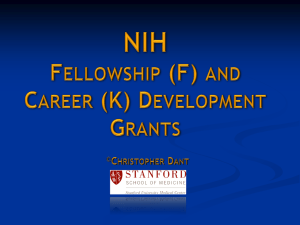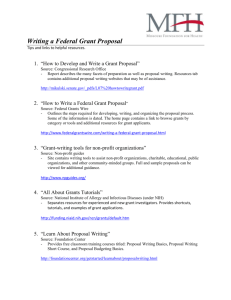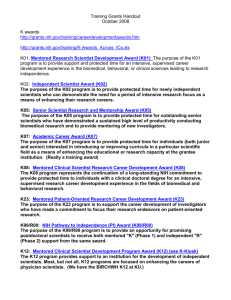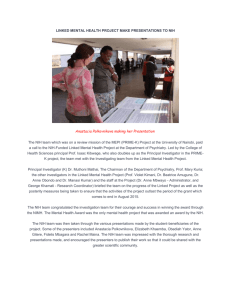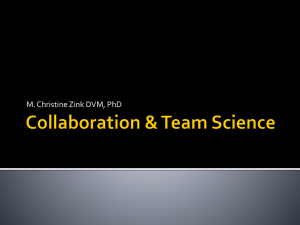Mapping your career with NIH
advertisement
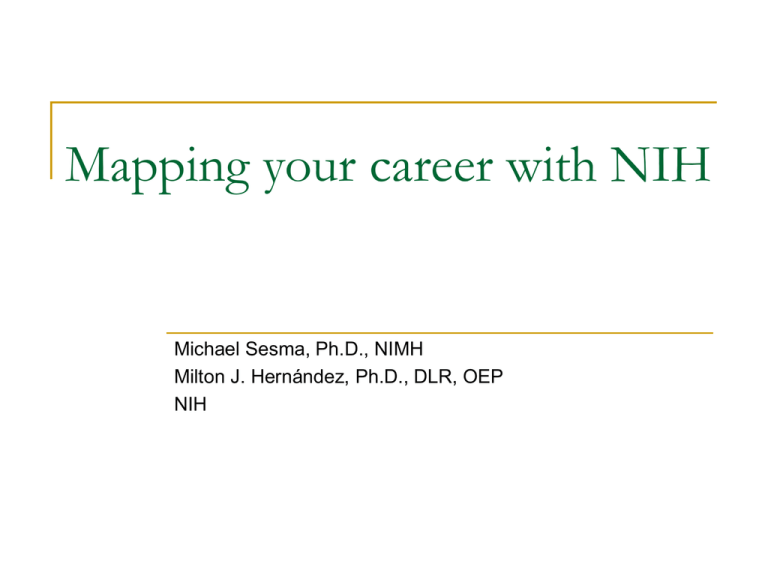
Mapping your career with NIH Michael Sesma, Ph.D., NIMH Milton J. Hernández, Ph.D., DLR, OEP NIH Basic Advice for Mapping Your Career with NIH Understand the NIH application process including the review process Understand the ICs and their goals Each IC has a research training and career development program Identify the grant programs offered by each IC Make early contact with program officers Find Mentors and Collaborators Study successful grant applications Only propose your best, creative ideas Appropriate number of goals Impact – now more important than ever Include preliminary data if you have it You won’t get a grant if you don’t apply Career Path for a Ph.D. T32- Institutional training grant (NRSA)-has pre-& postdoc slots F30 and F31- Individual predoc fellowship (NRSA) (some ICs only support Diversity F30/31s) F32- Individual postdoc fellowship (NRSA) F33- Sr. postdoc fellowship (NRSA) R03- Small Grant R21- Exploratory/Developmental Research Grant R01- Research grant K02- Independent Scientist Award K22- Research Scholar Development Award K99/R00- Pathway to Independence Award R37- Merit award P01- Program Project Grant U01- Cooperative Agreement T32 F31 Graduate student F32 K99/ Ps or K22 R03 R21 R01 K02 F33 R00 Us T32 Ph.D. Diversity Supplements Faculty Position Independent PI R37 Career Path for an MD T35- Short-term Training Grant for Health Professional Students F33- Sr. Postdoctoral Fellowship (NRSA) K08- Mentored Clinical Scientist Development Award K23- Mentored Patient-Oriented Research Career Development Award K24- Mid-Career Investigator in Patient-Oriented Research K07, K12- IC specific Plus all mechanisms from Ph.D. track T32 or F32 T35 Medical Student M.D. K08 K99/ R03 R21 R01 K02 F33 K24 R37 or K22 R00 K23 Clinical Training Diversity Supplements Faculty Position Independent PI Training Grants (Ts) NRSA- National Research Service Award Legislated, program began in 1974 (P.L. 93-348) Multi-slot awards Domestic institutions only Fund training programs for pre- and postdocs in any scientific area within our scientific mission Can be basic or clinical Trainees work in a mentor’s lab MDs, PhDs, DVMs Awards go the best training programs in the Nation Fellowships (Fs): NRSA- National Research Service Award Legislated, program began in 1974 (P.L. 93-348) Individual awards under a mentor Training can be at domestic or foreign institutions Fund pre- and postdoc trainees in any scientific area within our scientific mission Can be basic or clinical - most are basic Most awardees are for Ph.D.s F Kiosk: http://grants.nih.gov/training/F_files_nrsa.htm Career Development Awards (Ks) Individual awards Mechanisms for Basic and Clinical Investigators Designed as awards for faculty investigators Some mentored others not Newer programs (K22 and K99/R00) are transition awards- these are for MDs and PhDs K Kiosk: http://grants.nih.gov/training/careerdevelopmentawards.htm Training Grants Some all predoc/some all postdoc Most are a mixture of slots Funds are mostly for tuition and trainees Training Related Expenses may be used to defray costs such as staff salaries, equipment, research supplies, and other expenses directly related to the training program Costs: Tuition- 60% of requested tuition, capped at $16,000 ($21K for MDPhD programs) Stipends- $20,772 pre/ postdoc $36,996 (level 0)-$51,036 (level 7) Training Related Expenses- $4,200 pre/$7,850 (post); both include health insurance Travel- $400-$1000 F&As- 8% F30s and F31s- Predoc Fellowships Individual awards Cannot change the scope, move fellowship, or change mentor without prior NIH approval! (They do anyway) Predoctoral NRSA awards limited to 5 years total Tuition- 60% of requested tuition, capped at $16,000 ($21K for MD-PhD programs) Stipends- $20,772 pre Training Related Expenses- $4,200 includes health insurance Travel- $400-$1000 F&As- 8% F32s Postdoc NRSA Fellowships Postdoc only Individual award Cannot change the scope, move fellowship, or change mentor without prior NIH approval! (They do anyway) NRSA Support for up to 3 years total Stipends- $36,996 (level 0)-$51,036 (level 7) Training Related Expenses- $7,850; includes health insurance Travel- $400-$1000 F&As- 8% F33s Senior Postdoc Fellowships Not for postdocs who have been postdocs a long time Used for associate or full professors who want support for a sabbatical For MDs or PhDs Few applicants - too little money Stipend = $51,036 Training Related Expenses - $7,850; includes health insurance Travel- $400-$1,000 Fellowship Review Criteria In addition to an Overall Impact score there are 5 Core Review Criteria for Fellowships. These are distinct from R-type award Core Criteria; criterion scores will be provided by the reviewers (1-9) Fellowship Applicant Sponsors, Collaborators, and Consultants Research Training Plan Training Potential Institutional Environment & Commitment to Training K01 Mentored Research Scientist Development Award Support development experiences leading to research independence, training in new field or following hiatus in a research career (varies by IC) MDs or PhDs 3-5 years Salary Cap varies by IC + FBs Research Support: up to $50,000/yr (varies by IC) F&As= 8% IC contacts and policies: http://grants2.nih.gov/grants/guide/pa-files/PA-10-056.html K02 Independent Scientist Award Often called Mid-career award; Best candidate is a “senior” assistant professor or “junior” associate professor Close to or recently promoted and tenured Must have independent grant support as PI, e.g., R01 MDs (very few) and PhDs Salary support only Salary Cap varies by IC + FBs for up to 5 years Gives up salary support from all other NIH grants! Relatively few applicants F&As= 8% http://grants.nih.gov/grants/guide/contacts/parent_K02.html K08- Mentored Clinical Scientist Development Award K23- Mentored Patient-Oriented Research Career Development Award K08 - supports didactic study and mentored research for individuals with clinical doctoral degrees K23 - for clinical/patient-oriented project 3-5 yr award, varies by IC Salary cap varies by IC + FBs Research Support up to $50,000/yr (varies by IC) F&As= 8% For IC Contacts and policies http://grants.nih.gov/grants/guide/contacts/parent_K08.html http://grants.nih.gov/grants/guide/contacts/parent_K23.html K24 Mid-Career Investigator Award in Patient-Oriented Research Purpose: to provide support for clinician investigators to allow them protected time to devote to patient-oriented research (POR) and to act as research mentors primarily for junior clinicians 3-5 years Typically MDs Salary cap varies by IC + FBs Research Support $25,000 - $50,000 (varies by IC) F&As= 8% http://grants.nih.gov/grants/guide/contacts/parent_K23.html K25 Mentored Quantitative Research Development Award For individuals from a quantitative background (e.g., mathematics, statistics, economics, computer science, imaging science, informatics, physics, chemistry, and engineering) who want to apply their expertise to a biomedical problem and are not already working in a health or disease related topic 3-5 years Salary cap varies by IC + FBs Research Support: $20,000 - $50,000 (varies by IC) F&As= 8% http://grants.nih.gov/grants/guide/contacts/parent_K25.html K99/R00 Pathway to Independence Award Supported by almost all ICs with variations* Transition award for postdocs moving to assistant professor positions (tenure track or equivalent) No Citizenship/Green Card requirement K99 mentored phase (up to 2 years) R00 independent phase (up to 3 years; 75% effort) Requires mentor(s) *Up to $90,000/yr total cost for K99 phase; 8% F&A $249,000/yr total cost for R00 phase http://grants.nih.gov/grants/guide/contacts/parent_K99_R00.html K22 Research Scholar Development Award Offered by NCI, NHLBI, NIAID, NIAAA, NINR Transition award for postdocs moving to positions of assistant professor Two-phased application Phase 1 If applicant gets a fundable score, they have a year to find a position as assistant professor Phase 2 Scientific merit No institution yet Assistant Professor Own lab Significant start-up funds Little teaching/ no administrative responsibilities F&As= 8% K22 and the K99/R00 Award Main features K22 K99/R00 Transition award (postdocto-asst. professor) 2 yr award No mentored phase Awardee gets funds at the time of becoming asst. professor $250K + 8% F&A costs Total Cost= $270K Transition award (postdoc - to asst. professor) 3 year award only 2 yr mentored phase ($90K/yr TC) Awardee becomes asst. professorR00 not peer reviewed 3 yr independent R phase ($249K/yr TC) Total Cost= $574K but note TC in R00 phase Career Award Review Criteria In addition to an Overall Impact score there are 5 Core Review Criteria for K-award applications that are distinct from R-type award Core Criteria; criterion scores will be provided by the reviewers (1-9) Candidate Career Development Plan/Career Goals & Objectives/Plan to Provide Mentoring Research Plan Mentor(s), Consultants(s), Collaborator(s). Environment and Institutional Commitment to the Candidate New NIH Policy Encourage New Investigator Applications for the R01 % First-Time Investigators In recent years the use of Small Grants (R03) and the NIH Exploratory /Developmental Research Grant (R21) has increased : New Investigator policies are limited to applications for Traditional Research project grant (R01) support. Accordingly, the NIH is strongly encouraging New Investigators, particularly Early Stage Investigators, to apply for R01 grants when seeking first-time NIH funding. 22 Why an R01? It is the Gold Standard Grant! • The Research Project Grant (R01) is the original and historically oldest grant mechanism used by NIH. The R01 provides support for health-related research and development based on the mission of the NIH. • R01s can be investigator-initiated or can be in response to a program announcement or request for application. • The R01is an award made to support a discrete, specified, circumscribed project to be performed by the named investigator(s) in an area representing the investigator's specific interest and competencies, based on the mission of the NIH. 23 Are You a “New Investigator”? Definition: New Investigator (NI) is a PD/PI who has not yet competed successfully for a substantial NIH research grant (Except for R03, R15, R21 or mentored K awards) Definition: Early Stage Investigator (ESI) is a NI who is within 10 years of completing the terminal research degree or is within 10 years of completing medical residency (or equivalent) NI/ESI receive special considerations during peer review and IC funding decisions Resource web site with further information grants1.nih.gov/grants/new_investigators grants.nih.gov/grants/guide/notice-files/NOT-OD-08-121.html 24 New/Early Stage Investigators Identification of NI/ESI Applicants PURPOSE Encourage and accelerate earlier transition to research independence (i.e., first R01) Counter trend of increasing time spent in training phase of career Strongly encourage New Investigators, particularly ESIs, to apply for R01 grants when seeking first-time NIH funding http://grants.nih.gov/grants/guide/notice-files/NOT-OD-08-121.html New/Early Stage Investigator New and Early Stage Investigator Policies • ESI/NI Applications will be identified to reviewers so that appropriate consideration of career stage can be applied during review. • Apprise NIH staff of ESI/NI status, which will be considered when applications are selected for award • Support New Investigators (majority expected to be ESIs) at success rates equivalent to that of established investigators submitting new applications • For multiple PD/PI applications, all PD/PIs must meet requirements for ESI status to receive consideration during review • ESIs/NIs are eligible for the Shortened Review Cycle option (http://grants.nih.gov/grants/guide/notice-files/NOT-OD-07-083.html ) 26 New/Early Stage Investigators Information Sources • NOT-OD-08-121 (09/26/2008) - Encouraging Early Transition to Independence: Identifying ESIs http://grants1.nih.gov/grants/guide/notice-files/not-od-08-121.html • NOT-OD-09-013 (09/31/2008) – Revised New and Early Stage Investigator Policies http://grants1.nih.gov/grants/guide/notice-files/NOT-OD-09-013.html • NOT-OD-09-034 (12/31/2008) – ESI Policies: Requesting an Extension of the ESI Period http://grants.nih.gov/grants/guide/notice-files/NOT-OD-09-034.html • FAQs: http://grants.nih.gov/grants/new_investigators/investigator_policies_faqs.ht ml 27 Other NIH Awards for New Investigators http://nihroadmap.nih.gov/ newinnovator/ • Support exceptionally innovative research with potential for significant impact • Launched in 2007 • • • Open to new investigators within ten years of their terminal degree Appointment at US institutions Commit at least 25% effort • Up to $1.5 million over 5 years (direct costs) • Abbreviated application • Preliminary data optional • Review focus on innovation and creativity, scientific impact • Number of Applications and awards • • • 28 2007 2008 2009 2150 579 419 30 31 ? + ARRA Loan Repayment Programs An Overview Division of Loan Repayment (DLR) Office of Extramural Research/Office of Extramural Programs National Institutes of Health U.S. Department of Health and Human Services Milton Hernández, Ph.D. Director NIH Division of Loan Repayment, OEP Program Overview NIH Loan Repayment Programs (LRPs) •Vital component of our Nation's efforts to attract and retain highly qualified health professionals •Working in priority areas •To build a research workforce that will meet our future national needs 30 Loan Repayment Programs Intramural Programs (1989 to Present) AIDS Research LRP (1989) Clinical Research LRP for Individuals from Disadvantaged Backgrounds (1994) General Research LRP (1996) Extramural Programs (2001 to Present) Contraception & Infertility Research LRP (1997) Health Disparities Research LRP (2001) Clinical Research LRP for Individuals from Disadvantaged Backgrounds (2001) Clinical Research LRP (2002) Pediatric Research LRP (2002) 31 LRPs- How do they work? • Up to $35,000 per year in loan repayment depending on debt level • Coverage of Federal, state and local taxes resulting from the NIH LRP • 2 year initial contracts with 1 – 2 year competitive extension contracts Individual LRP Funding History FY 2002 thru FY 2008 $80,000 Funding Amount (Thousands) $70,000 Contraception and Infertility $60,000 Clinical DB $50,000 Health Disparities $40,000 $30,000 Pediatric $20,000 Clinical $10,000 $0 FY 2002 FY 2003 FY 2004 FY 2005 FY 2006 FY 2007 FY 2008 33 Educational Debt, by Degree Type Trends Analysis, FY03-FY07 Among LRP applicants, academic Number of New LRP Applicants doctorates have a higher debt load 1200 than recent PhD graduates, and 1000 physician doctorates have a lower debt load than recent MD graduates. 800 600 MD 400 LRP All* LRP All† No Debt n/a 17% n/a 50% <$40K 10% 13% 38% 40% >$40K 90% 73% 62% 10% $114K $97K $62K ~$20K Academic Doctorate 200 Physician Doctorate Physician Doctorate / Academic Doctorate 0 Professional Clinical Doctorate Allied Health Professional PhD Average Debt Educational Debt Level (reported by applicants, in thousands) *Source: Survey of Graduates, American Association of Medical Colleges (2001). †Source: Survey of Earned Doctorates, National Science Foundation (2003). 34 LRP Evaluation Conclusions: LRPs attract young scientists early in their careers- average age is 35 Applicants have considerable educational debt Women, MDs, and PhDs are adequately represented in applicant and awardee pools LRP awardees receive more RPGs than unsuccessful applicants But LRP awardees are not quite as successful as K awardees in receiving RPGs

